- Home
- James A. Michener
Alaska Page 3
Alaska Read online
Page 3
But most of Alaska escaped the glaciers. North of the Brooks Range, there were none.
In the vast middle section, between the mountain ranges, there were none, and in isolated parts of the region to the south, glaciers did not appear. At maximum, not more than thirty percent of the region was ice-covered.
However, the later ice ages did create in Alaska a result more dramatic than that which happened anywhere else in America, and for a reason which becomes evident once it is pointed out. If an ice sheet more than a mile thick is going to cover much of North America, the water it imprisons will have to come from somewhere, and it cannot come mysteriously from outer space. It cannot arrive on the surface of the earth; it can come only from water already here, which means that it must be stolen from the oceans. And that is what happened: dry winds whipping across the oceans lifted huge quantities of water that fell as cold rain over the high latitudes and as snow toward the poles. As it was compressed into ice it began to expand outward, covering hitherto barren sites, and causing more and more of the incoming moisture to fall as snow. This in turn fed the existing glaciers and created new ones.
In the recent period with which we are concerned, this theft of water continued for thousands of years, until the snowfields were immensely aggrandized and the oceans seriously depleted. In fact, when the deficiency was at its worst, only some twenty thousand years ago, the level of the world's oceans all of them was more than three hundred "feet lower than it is now. All the American states that faced the Atlantic Ocean had shorelines that extended miles farther eastward than they now do; much of the Gulf of Mexico was dry; Florida was not a peninsula nor was Cape Cod a cape.
Caribbean Islands coalesced into a few huge islands, and the shoreline of Canada could not be seen at all, for it was smothered in ice.
This sharp droppage in the level of the oceans meant that land areas which had previously been separated were now joined by necks of land which the subsiding waters revealed.
Australia was attached to Antarctica by such exposed land, Ceylon to India, Cyprus to western Asia, and England to Europe. But the most spectacular join was that of Alaska to Siberia, for it united two continents, allowing animals and people to pass from one to the other. It was also the only one which acquired its own name, scientists having christened it Beringia, the lost land of the Bering Sea.
It was, perhaps, unfortunate that the phrase land bridge was invented by geographers to designate this phenomenon of revealed land connections, because the imagery connected with the word bridge is misleading. The Alaskan-Siberian connection was no bridge in the ordinary sense, a narrow structure across which one could travel; it was an exposed sea floor some sixty miles east to west, but a full six hundred south to north. At its widest, it covered about the distance from Atlanta to New York (in Europe, Paris to Copenhagen).
It was four times wider than most of Central America from ocean to ocean, and if a man stood in the middle, he would hardly think of himself on a bridge; he would be on a substantial part of a continent. But it was an inviting passageway, and with its functioning the story of populated Alaska can begin. It starts with the earliest immigrants.
ABOUT THREE HUNDRED EIGHTY-FIVE THOUSAND YEARS ago, when the oceans and continents were in place as we know them today, the land bridge from Asia was open, and a huge, ponderous animal, looking much like an oversized elephant but with enormous protruding tusks, slowly made his way eastward, followed by four females and their young. He was by no means the first of his breed to lumber across the bridge, but he was among the more interesting, for his life experience symbolized the majestic adventure in which the animals of his period were engaged.
He was a mastodon, and we shall call him by that name, for he was a progenitor of those noble massive beasts who ranged Alaska. Obviously, a million years before, he had stemmed from the same source that produced the elephant, but in Africa, in Europe and later in central Asia he had developed those characteristics which differentiated him from his cousin the elephant. His tusks were larger, his front shoulders lower, his legs more powerful, and his body was covered with hair that was more visible.
But he behaved in much the same way, foraged for the same kinds of food, and lived to about the same age.
When he crossed the bridge less than seventy miles from Asia to Alaska Mastodon was forty years old and could expect to survive into his late seventies, supposing that he escaped the ferocious wild cats who relished mastodon meat. His four females were much younger than he, and as was common in the animal kingdom, they could anticipate a somewhat longer life.
As the nine mastodons entered Alaska they faced four radically different types of terrain, varying somewhat from the land they had left behind in Asia. At the farthest north, facing the Arctic Ocean, lay a thin strip of arctic desert, a bleak and terrifying land of shifting sands on which little that was edible grew. During the dozen winter weeks when no sun appeared, it was covered by thin snow that did not pile up into high drifts but was whipped by intense winds across the barren landscape until it came to rest in low drifts behind some ridge or rock.
Since none of his breed could survive long in this desert, Mastodon intuitively shied away from the far north, and this left him three other areas to explore that were more rewarding. Just south of the desert and blending into it in various ways stretched another relatively narrow strip, a tundra, perpetually frozen twelve to twenty-four inches below the surface but rich in rooted plant life when the topsoil was dry enough to permit growth. Here succulent lichens abounded and mosses rich in nutrients and even an occasional low shrub with branches stout enough to provide leaves for grazing.
No real trees grew here, of course, for summers were too short to permit flowering or adequate branch development, and this meant that whereas Mastodon and his family could eat well on the tundra during the long summers when nearly perpetual daylight spurred plant growth, they had to be careful to escape it when winter approached.
That left two rich areas between the northern and southern glaciers, and the first of these was a splendid, hospitable region, the great Alaskan steppe, an area of rich grass growing high most years and yielding some food even in poor years. Large trees did not customarily grow on the steppe, but in a few secluded spots that were protected from searing winds, clusters of low shrubs gained a foothold, especially the dwarf willow whose leaves Mastodon loved to crop. When he was especially hungry he liked to rip off the bark of the willow with his strong tusks, and sometimes he would stand for hours amidst a group of willows, browsing and eating a sliver of bark and striving to find among the low branches a bit of shade to protect himself from the intense heat of summer.
The fourth area he had at his disposal was larger than any of the previous three, for in these years Alaska had a predominantly benign climate which both allowed and encouraged the growth of trees in regions that had previously been denuded and would be again when temperatures lowered. Now poplar, birch, pine and larch flourished, with woodland animals like the spotted skunk sharing the forests with Mastodon, who relished the trees because he could stand upright and nibble at their copious leaves. After feeding, he could use the sturdy trunks of the pine or larch as convenient poles against which to scrape his back.
So between the largesse of the new woodland and the more controlled but assured richness of the steppe, Mastodon and his family could eat well, and since it was spring when they entered Alaska, he naturally headed for a region like the one he had known well in Siberia, the tundra, where he was certain that low shrubs and grasses waited.
But now he faced an interesting problem, for the sun's heat that had enabled these plants to grow also melted the top eight or ten inches of the permafrost, turning the softening soil into a kind of sticky mush. Obviously, there was nowhere for the moisture to escape; the earth below was frozen solid and would remain so for countless years. As summer approached, thousands of shallow lakes thawed, and the mush thickened until at times Mastodon sank in almost to his knees.
/>
Now he slipped and sloshed his way through the watery tundra, fighting off the myriad of mosquitoes that hatched at this time to torment any moving thing. Sometimes, when he lifted one of his huge legs out of the swampy mess in which it had slowly sunk, the sound of the leg breaking free from the suction echoed for long distances.
Mastodon and his group grazed on the tundra during most of that first summer, but as the waning heat of the sun signaled the approach of winter, he began drifting gradually south toward the waiting steppe where there would be reassuring grass poking through the thin snow. During the early days of autumn, when he was at the dividing line -between tundra and steppe, it was almost as if the shrub willows that now appeared low on the horizon were calling him to a safer winter home, but the effect of the waning sun was the more important impulse, so that by the time the first snows appeared in the area between the great glaciers, he and his family had moved into the forested area which assured an ample food supply.
His first half-year in Alaska had been a spectacular success, but of course he was not aware that he had made the transition from Asia to North America; all he had done was follow an improved food supply. Indeed, he had not left Asia, for those solid sheets of ice to the east had made Alaska in those years a part of the larger continent.
AS THE FIRST WINTER PROGRESSED, MASTODON BECAME aware that he and the other mastodons were by no means alone in their favorable habitat, for a most varied menagerie had preceded them in their exit from the Asian mainland, and one cold morning when he stood alone in soft snow, cropping twig-ends from a convenient willow, he heard a rustle that disturbed him. Prudently, he withdrew lest some enemy leap upon him from a hiding place high in the trees, and he was not a moment too soon, for as he turned away from the willow, he saw emerging from the protection of a nearby copse his most fearsome enemy.
It was a kind of tiger, with powerful claws and a pair of frightful upper teeth almost three feet long and incredibly sharp. Mastodon knew that though this saber-tooth could not drive those fearsome teeth through the heavy skin of his protected rear or sides, it could, if it obtained a secure foothold on his back, sink them into the softer skin at the base of his neck. He had only a moment to defend himself from this hungry enemy, and with an agility that was surprising for an animal so big, he pivoted on his left front foot, swung his massive body in a half-circle, and faced the charging saber-tooth.
Mastodon had his long tusks, of course, but he could not lunge forward and expect to impale his adversary on them; they were not intended for that purpose. But his tiny brain did send signals which set the tusks in wide sweeping motions, and as the cat sprang, hoping to evade them, the right tusk, swinging with tremendous force, caught the rear legs of the saber-tooth, and although the blow did not send the cat spinning or in any way immobilize it, it did divert the attack and it did cause a bruise which infuriated the saber-tooth without disarming him.
So the cat stumbled among the trees, then regained control, and circled swiftly so that it could attack from the rear, hoping with a giant leap to land upon Mastodon's back, from where the vulnerable neck could be punctured. The cat was much quicker than the mastodon, and after a series of feints which tired the larger animal as he tried to counter them, the saber-tooth did land with a mighty bound, not on the flat of the back where it wanted to be, but half on the back, half on the side. It struggled for a moment to climb to a secure position, but in that time Mastodon, with a remarkable instinct for self-preservation, scraped under a set of low branches, and had the cat not wisely jumped free, it would have been crushed, which was what Mastodon intended.
Repelled twice, the great cat, some nine times larger than the tiger we know today, growled furiously, lurked among the trees, and gathered strength for a final attack.
This time, with a leap more powerful than before, it came at Mastodon from the side, but the huge animal was prepared, and pivoting again on his left front foot, he swung his tusks in a wide arc that caught the saber-tooth in midair and sent it sprawling back among the trees, one of its legs painfully damaged.
That was enough for the saber-tooth. Growling and protesting, it slunk away, having learned that if it wanted to feast on mastodon, it must hunt in pairs, or even threes or fours, because one wily mastodon was capable of protecting itself.
Alaska at this time contained many lions, huge and much hairier than the kind that would come later. These possessed no handsome manes or wavy tails, and the males lacked the regal quality that would someday be such a distinguishing characteristic; they were what nature intended them to be: great cats with remarkable hunting abilities.
Like the sabertooth, they had learned never to attack a mastodon singly, but a hungry pride of six or seven could badger him to death, so Mastodon never intruded upon areas where a number of lions might be hiding. Rocky tors covered with trees, deep vales from whose sides groups of lions might attack, these he avoided, and sometimes as he plowed noisily along, bending young and scattered trees to his will, he would see a group of lions in the distance feeding upon some animal they had run to earth, and he would change direction lest he attract their attention.
The water animal with which Mastodon occasionally came into contact was the massive beaver, which had followed him out of Asia. Of giant size and with teeth that could fell a large tree, these beavers spent their working hours building dams, which Mastodon often saw from a distance, but when work was done the great beasts, their heavy fur glistening in the cold sunlight, liked to play at rowdy games, and their agility differed so markedly from the ponderous movements of Mastodon that he was amazed at their antics. He never had occasion to live in close contact with the underwater beavers, but he noticed them with perplexity when they gamboled after work.
Mastodon had his major contacts with the numerous steppe bison, the huge progenitors of the buffalo. These shaggy beasts, heads low and powerful horns parallel to the ground, grazed in many of the areas he liked to roam, and sometimes so many bison collected in one meadow that the land seemed covered with them. They would all be grazing, heads pointed in the same direction, when a saber-tooth would begin stalking a laggard. Then, at some signal Mastodon could not detect, the hundreds of giant bison would start running away from the terrible fangs of the cat, and the steppe would thunder with their passage.
Occasionally he encountered camels. Tall, awkward beasts who cropped the tops of trees, they seemed to fit in nowhere, moving slowly about, kicking ferociously at enemies, and surrendering quickly whenever a saber-tooth managed a foothold on their backs. At rare times Mastodon and a pair of camels would feed in the same area, but the two animals, so vastly different, ignored each other, and it might be months before Mastodon saw another camel. They were mysterious creatures and he was content to leave them alone.
In this placid, ponderous way, Mastodon lived out his uneventful life. If he defended himself against sabertooths, and avoided falling into bogs from which he could not scramble free, and fled from the great fires set by lightning, he had little to fear.
Food was plentiful. He was still young enough to attract and hold females. And the seasons were not too hot and moist in summer or cold and dry in winter. He had a good life and he stumbled his gigantic way through it with dignity and gentleness.
Other animals like wolves and sabertooths sought sometimes to kill him for food, but he hungered only for enough grass and tender leaves, of which he consumed about six hundred pounds a day. He was of all Alaska's inhabitants in these early years the most congenial.
A CURIOUS PHYSICAL CONDITION LIMITED THE MOVEMENT of animals in Alaska, for Beringia's land bridge could exist only when the polar ice caps were so extensive that they imprisoned vast quantities of water which had previously sustained the oceans. Indeed, the prime requisite for the existence of the bridge was that the ice sheets be immense.
However, when they were, they crept across western Canada, and although they never reached Alaska in an unbroken mass, they did send forth probing glaciers,
and in time these frozen fingers reached right down to the Pacific shoreline, forming a set of icy barriers which proved impassable to animals and men. Alaska was then easy to enter from Asia, impossible to leave for the interior of North America. Functionally, Alaska became a part of Asia, and so it would remain during vast periods.
At no time that we are aware of could any animal or man cross the bridge and proceed directly to the interior of North America; but since we know that eventual passage did occur, for mastodons, bison and sheep did move from Asia into mainland North America, as did men, we must conclude that such movement came only after an extended waiting period in Alaska's ice castle.
Proof of this can be found in varied data. Certain animals that came into Alaska remained there, while their brothers and sisters wandered on to the rest of North America during some interval when the barriers were removed.
But the two strains became so totally separated when the barriers closed that over the thousands of years that they remained apart they each developed unique characteristics.
The movement of animals across the bridge was by no means always in one direction, for although it is true that the more spectacular beasts mastodon, saber-tooth, rhinoceros came out of Asia to enrich the new world, other animals like the camel originated in America and carried their wonderful capacities into Asia. And the intercontinental exchange which had the most remarkable consequences also moved westward across the bridge and into Asia.
One morning as Mastodon browsed among cottonwood trees near the edge of a swamp in central Alaska, he saw approaching from the south a line of animals much smaller than he had ever seen before. Like him, they walked on four feet; but unlike him, they had no tusks, no heavy covering of hair, no massive head or ponderous feet.

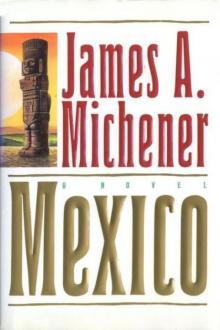 Mexico
Mexico The World Is My Home: A Memoir
The World Is My Home: A Memoir Sayonara
Sayonara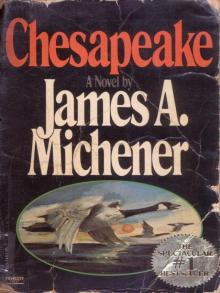 Chesapeake
Chesapeake The Novel
The Novel Rascals in Paradise
Rascals in Paradise Return to Paradise
Return to Paradise Presidential Lottery: The Reckless Gamble in Our Electoral System
Presidential Lottery: The Reckless Gamble in Our Electoral System The Source
The Source Poland
Poland Space
Space Caravans
Caravans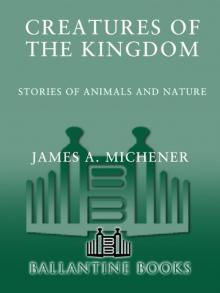 Creatures of the Kingdom: Stories of Animals and Nature
Creatures of the Kingdom: Stories of Animals and Nature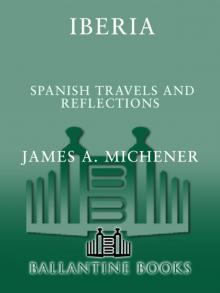 Iberia
Iberia Hawaii
Hawaii The Watermen: Selections From Chesapeake
The Watermen: Selections From Chesapeake Report of the County Chairman
Report of the County Chairman The Covenant
The Covenant The Bridges at Toko-ri
The Bridges at Toko-ri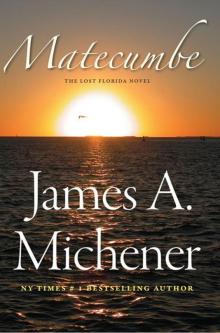 Matecumbe
Matecumbe Journey: A Novel
Journey: A Novel Centennial
Centennial Sports in America
Sports in America Texas
Texas Miracle in Seville
Miracle in Seville This Noble Land: My Vision for America
This Noble Land: My Vision for America Tales of the South Pacific
Tales of the South Pacific Bridges at Toko-Ri
Bridges at Toko-Ri Space: A Novel
Space: A Novel Presidential Lottery
Presidential Lottery Sayonara: A Novel
Sayonara: A Novel This Noble Land
This Noble Land The Covenant: A Novel
The Covenant: A Novel Miracle in Seville: A Novel
Miracle in Seville: A Novel The Bridge at Andau
The Bridge at Andau Source
Source The Source: A Novel
The Source: A Novel Journey
Journey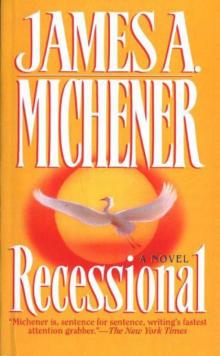 Recessional: A Novel
Recessional: A Novel Legacy: A Novel
Legacy: A Novel The Bridges at Toko-Ri: A Novel
The Bridges at Toko-Ri: A Novel Poland: A Novel
Poland: A Novel